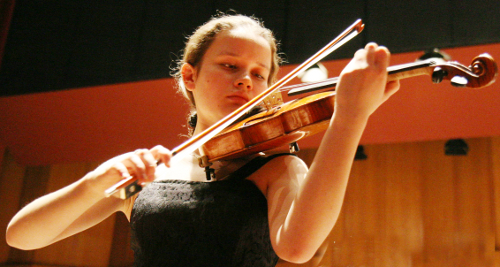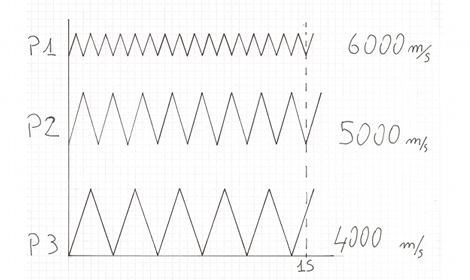ROAD TESTHere we are again, after the two pieces posted by Simone to whom I repeat my thanks, I consider it as proper, at this point, to resume a little bit all the topics I dealt with until now. We have dealt with many topics about the “Bow machine” we have checked the engine (sound velocity), the tyres ( curve), the structure (torsions and distorsions), we have tried to watch it and to test it with a glance; we just have to come aboard and start a lap. !
Before entering my explanations about the proper and quick way to test a bow, I wish to express my thanks to Miss Maria Kouznetsova, the beautiful girl in the picture. She is a young promise and talented violin player, that kindly accepted to act as a model for my explanation. Much to my regret, I am not able to let you listen to her: it would really be a charming experience. It is not so easy to ascertain the right peculiarities of a bow in few minutes.
Usually you try it in an unfamiliar acoustic environment, with a bow maker speaking to you and a variety of unknown things that don’t help at all to understand tens or twenty bows submitted to you for your evaluation. If you start testing a bow, as I personally could see many times , playing few notes of a piece, concert or capriccio, you will get information that will not own a certain reliability and your sensations will not give you right information about the power capabilities of the item you are handling with. All above is possible if you are at a good instrumental level, in fact, if you are a student or a beginner so not so able to judge by yourself, you will trust a more expert opinion. The problem in this case will be even bigger, because even assuming that the person you turn to have an evaluation is a very honest one, very rarely indeed, he has in any case his different muscle, way of playing and listening capabilities can sharply differ from your own ones.
Therefore the bow that suits him so well, may be doesn't meet your own requirements. There is a way that allows a sure evaluation of the bow qualities in few seconds. When you test a bow, when you watch it, we need to know what to look for. We already told that both mechanic and sound require a big hall and time. You have to choose in a short time, sometime a hour or two, which bow is the better one, which one you have to carry home and played in a deeper way, so if you do not have a method to follow, the risk is to make a mistake. To carry out this test you have to place the head of the bow in the 4th string near the bridge as you can see in the picture. Photo 1 Furthermore, try to hold the frog only with your thumb, if you can so to verify that your way of how to handle a bow will affect it. (Photo 2)
Photo 2 Now you can go on, using only the first 2, 3 cm of the bow, and start going up and down, in a slow way. Of course, it is very difficult to emit a sound in these conditions, but this is not our purpose and you don’t have to look for it. Just listen to the effect you produce. If the material with which the bow has been made is of a good quality , you obtain - figuratively speaking a scratchy sound but, if the wood is of a poor quality, you obtain just a blow. The best material gives the most scratchy sound, therefore with this simple test that everybody can carry out ad that is not at all time spending, you already eliminate 80 per cent of the bows submitted to you. Now we can pass from 20 to 5.
To detect these defects it is enough to try a pianissimo note on the bridge and all throughout the bow length. Carrying out this stroke up and down, try to play in a way
If the vibrations are very tight, (P1) it means that the wood fiber is very nervous and continuous, for this reasons you will be able to keep a longer note in comparison with the example (P3) where the vibrations are very wide. Comparing two bows, the one that allows you to decrease speed – provided that the emitted sound volume is the same – is the one made with the better wood. Next week we will go on speaking about the best evaluation methods to test a bow, in the meantime you can try to understand what is the quality of the wood of your bow. So long Paolo
|
   |







